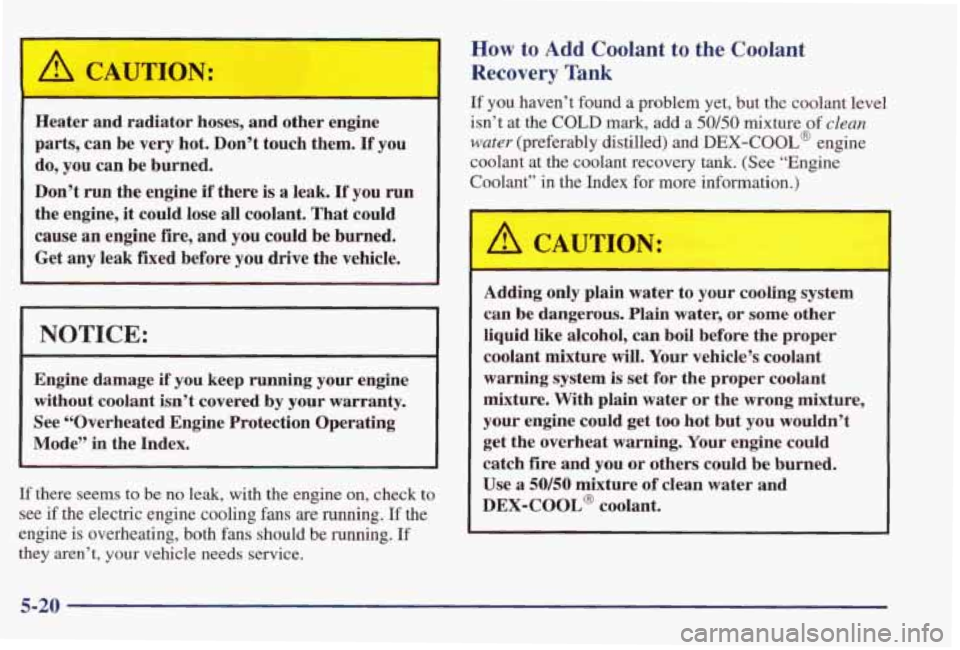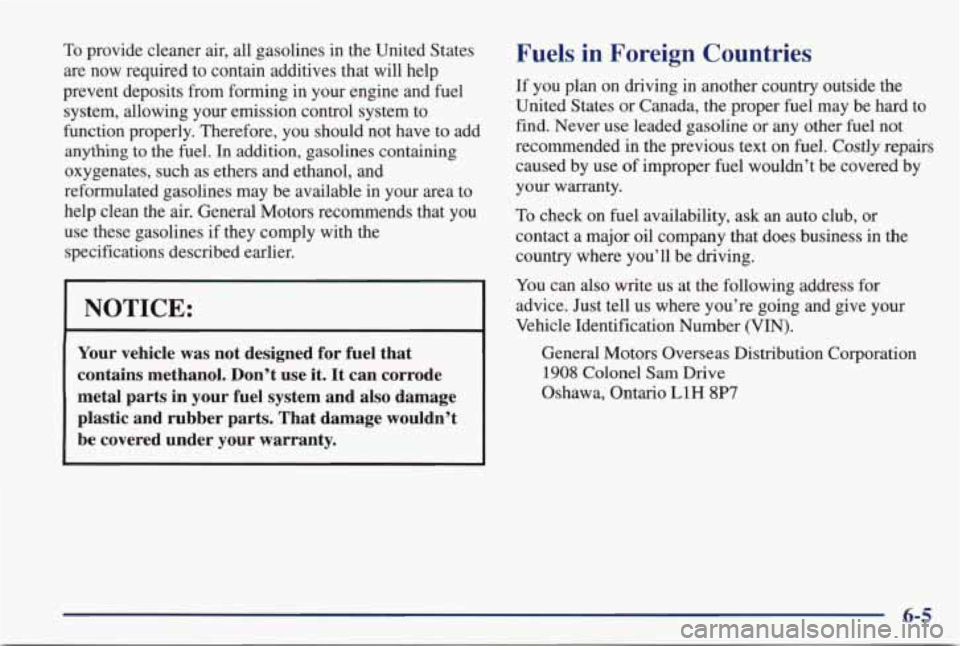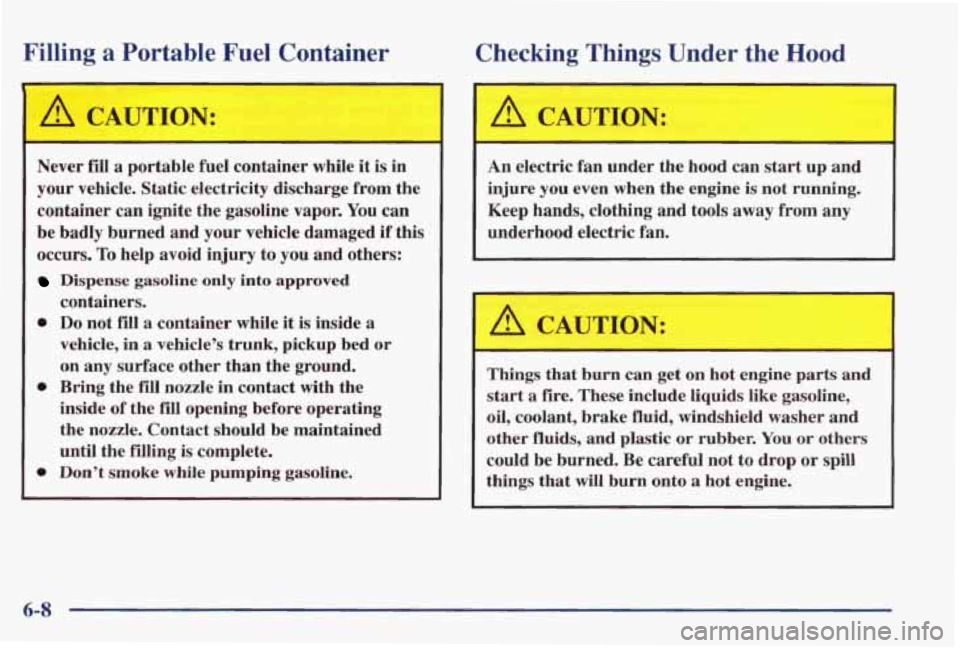Page 255 of 402

I A CAUTION: I
Heater and radiator hoses, and other engine
parts, can be very hot. Don’t touch them.
If you
do, you can be burned.
Don’t run the engine
if there is a leak. If you run
the engine, it could lose all coolant. That could
cause
an engine fire, and you could be burned.
Get any leak fined before you drive the vehicle.
NOTICE:
Engine damage if you keep running your engine
without coolant isn’t covered by your warranty.
See “Overheated Engine Protection Operating
Mode” in the Index.
If there seems to be no leak, with the engine
on, check to
see if the electric engine cooling fans are running. If the
engine is overheating,
both fans should be running. If
they aren’t, your vehicle needs service.
How to Add Coolant to the Coolant
Recovery Tank
If you haven’t found a problem yet, but the coolant level
isn’t at the
COLD mark, add a 50/50 mixture of clean
wuter (preferably distilled) and DEX-COOL@ engine
coolant at the coolant recovery tank. (See “Engine
Coolant”
in the Index for more information.)
Adding only
plain water to your cooling system
can
be dangerous. Plain water, or some other
liquid like alcohol, can boil before the proper
coolant mixture
will. Your vehicle’s coolant
warning system
is set for the proper coolant
mixture. With plain
water or the wrong mixture,
your engine could get too hot but you wouldn’t
get the overheat warning. Your engine could
catch fire and you or others could
be burned.
Use
a 50/50 mixture of clean water and
DEX-COOL@ coolant.
5-20
Page 276 of 402

Section 6 Service and Appearance Care
Here you will find information about the care of your vehicle. This section begins with service and fuel informa\
tion,
and then it shows how to check important fluid and lubricant \
levels. There
is also technical information about your
vehicle, and
a part devoted to its appearance care.
6-2
6-3
6-5
6-6
6-8
6-8
6-
13
6-20
6-22
6-26
6-32
6-33
6-36
6-37
6-44 Service
Fuel
Fuels in Foreign Countries
Filling Your Tank
Filling a Portable Fuel Container Checking Things Under the Hood
Engine Oil Air Cleaner
Automatic Transaxle Fluid
.
Engine Coolant
Windshield Washer Fluid
Brakes
Battery
Bulb Replacement
Windshield Wiper Blade Replacement 6-44
6-52
6-53 6-55
6-56
6-57
6-59
6-60
6-6 1
6-6
1
6-62
6-68
6-70
6-70 Tires
Appearance Care
Cleaning the Inside of
Your Vehicle
Care
of the Safety Belts and Built-in Child
Restraint Harness Cleaning the Outside
of Your Vehicle
Cleaning Aluminum Wheels
(If Equipped)
Underbody Maintenance
Appearance Care Materials Chart
Vehicle Identification Number (VIN)
Service
Parts Identification Label
Electrical System
Capacities and Specifications Normal Maintenance Replacement
Parts
Air Conditioning Refrigerants
Page 280 of 402

To provide cleaner air, all gasolines in the United States
are now required to contain additives that will help
prevent deposits from forming in your engine and fuel system, allowing your emission control system to
function properly. Therefore, you should not have to add
anythmg to the fuel. In addition, gasolines containing
oxygenates, such as ethers and ethanol, and
reformulated gasolines may be available in your area to
help clean the
air. General Motors recommends that you
use these gasolines if they comply with the specifications described earlier.
NOTICE:
Your vehicle was not designed for fuel that
contains methanol. Don’t use it. It can corrode
metal parts in your fuel system and
also damage
plastic and rubber parts. That damage wouldn’t
be covered under your warranty.
Fuels in Foreign Countries
If you plan on driving in another country outside the
United States or Canada, the proper fuel may be hard to
find. Never use leaded gasoline
or any other fuel not
recommended in the previous text on fuel.
Costly repairs
caused by use
of improper fuel wouldn’t be covered by
your warranty.
To check on fuel availability, ask an auto club, or
contact a major oil company that does business in the
country where you’ll be driving.
You can
also write us at the following address for
advice. Just tell us where you’re going and give your
Vehicle Identification Number (VIN).
General Motors Overseas Distribution Corporation
1908 Colonel Sam Drive
Oshawa, Ontario L1H 8P7
6-5
Page 283 of 402

Filling a Portable Fuel Container
A CAUTION:
Never fill a portable fuel container while it is in
your vehicle. Static electricity discharge from the
container can ignite the gasoline vapor. You can
be badly burned and your vehicle damaged
if this
occurs.
To help avoid injury to you and others:
Dispense gasoline only into approved
containers.
0 Do not fill a container while it is inside a
vehicle, in a vehicle’s trunk, pickup bed
or
on any surface other than the ground.
0 Bring the fill nozzle in contact with the
1 inside of the fill opening before operating
the nozzle. Contact should be maintained
1 until the filling is complete.
~ 0 Don’t smoke while pumping gasoline.
i
Checking Things Under the Hood
A CAUTION: I
An electric fan under the hood can start up and
injure you even when the engine
is not running.
Keep hands, clothing and tools away from any
underhood electric fan.
Things that burn can get on hot engine parts and
start a fire. These include liquids like gasoline,
1 oil, coolant, brake fluid, windshield washer and
other fluids, and plastic
or rubber. You or others
could be burned. Be careful not to drop or
spill
things that will burn onto a hot engine.
6-8
Page 288 of 402

Before closing the hood, be sure all the filler caps are
on properly. Then just pull the hood down and close
it fiiy.
3800 Supercharged Engine
(If Equipped)
Your vehicle may have a 3800 Supercharged engine.
The supercharger is a device which is designed to pump
more air into the engine than it would normally use.
This air, mixed with fuel, creates increased engine
power. Since the supercharger is a pump and is driven
from an engine accessory drive belt, increased pressure
is available at all driving conditions.
The Powertrain Control Module (PCM) works with a
vacuum control to regulate the increased pressure
required during specific driving conditions. When this
increased pressure or boost is not desired, such as during
idling and light throttle cruising, the excess air that the supercharger is pumping is routed through a bypass.
All of these controls working together provide high
performance character and fuel efficiency
in the
3800 Supercharged engine.
Engine Oil
LOW OIL
LEVEL
If the LOW OIL LEVEL
light on the instrument
panel comes on, it means
you need to check
your
engine oil level right away.
For more information, see “Low
Oil Level Light” in the
Index. You should check your engine oil level regularly;
this is an added reminder.
It’s a good idea to check your engine oil every time you
get fuel. In order to get an accurate reading, the oil must
be warm and the vehicle must be on level ground.
The engine oil dipstick
handle is the yellow loop
near the front of the engine.
6-13
Page 289 of 402
I
1
I
3 Checking Engine Oil
3800 or 3800 Supercharged Engine
Turn off the engine and give the oil a few minutes to
drain back into the oil pan.
If you don’t, the oil dipstick
might
not show the actual level. Pull out the dipstick
and clean
it with a paper towel or
cloth, then push it back in all the way. Remove it again,
keeping the tip
down, and check the level.
3100 Engine
6-14
Page 296 of 402

Supercharger Oil
Unless you are technically qualified and have the proper
tools,
you should let your dealer or a qualified service
center perform this maintenance.
When to Check
Check oil level every 30,000 miles (50 000 km) or every
36 months, whichever occurs first.
What Kind of Oil to Use
See “Recommended Fluids and Lubricants” in the Index
and use only the recommended oil,
How to Check and Add Oil
Check oil only when the engine is cold. Allow the
engine to cool two to
three hours after running.
A CAUTION:
If you remove the supercharger oil fill plug while
the engine is hot, pressure may cause hot
oil to
blow out
of the oil fill hole. You may be burned.
Do not remove the plug until the engine cools.
1. Clean the area around the oil fill plug before
2. Remove the oil fill plug using a 3/16 inch
3. The oil level is correct when it just reaches the
bottom
of the threads of the inspection hole.
removing
it.
Allen wrench.
4. Replace the oil plug with the O-ring in place. Torque
to
88 lb-in (10 N-m).
6-21
Page 297 of 402

Automatic Transaxle Fluid
When to Check and Change
A good time to check your automatic transaxle fluid
level is when the engine oil is changed.
Change both the fluid and filter every
50,000 miles
(83 000 km) if the vehicle is mainly driven under one or
more of these conditions:
0 In heavy city traffic where the outside temperature
In hilly or mountainous terrain.
regularly reaches
90” F (32 O C) or higher.
0 When doing frequent trailer towing.
0 Uses such as found in taxi, police or delivery service.
If you do not use
your vehicle under any of these
conditions, the fluid and filter
do not require changing.
See “Scheduled Maintenance Services” in the Index.
How to Check
Because this operation can be a little difficult, you may
choose to have
this done at your Pontiac dealership
Service Department.
If you do
it yourself, be sure to follow all the
instructions here, or you could get a false reading on
the dipstick.
NOTICE:
Too much or too little fluid can damage your
transaxle.
Too much can mean that some of the
fluid could come out and fall on
hot engine parts
or exhaust system parts, starting a fire. Be sure to get an accurate reading if you check your
transaxle fluid.
6-22